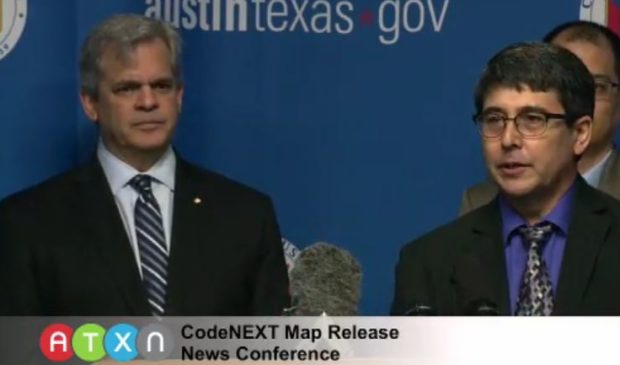CodeNEXT maps unveiled
Wednesday, April 19, 2017 by
Jack Craver The consultants hired to craft a new land-use code for the city of Austin have finally unveiled maps showing what their proposed new system of zoning would look like.
But as City Council begins its examination of the proposed CodeNEXT maps, it is far from clear how closely they will resemble the final product put in place by Council.
Well before the maps were made public on Tuesday, April 18, Mayor Steve Adler stressed that the unveiling marked only the starting point of the code overhaul, after which the maps will be shaped on the basis of input from the community and Council.
Adler emphasized that point again at a press conference Tuesday morning, asking all interested parties to “chill” while city leaders consider how to improve the maps. He projected confidence about the outcomes, calling the release of the first drafts a great day for Austin.
The mayor also repeated his commitment to what he has termed the “Austin Bargain,” an attempt to address the high demand for housing and rising rents without disrupting the character of established single-family neighborhoods. To that end, Adler has said the city will focus on building more housing along the city’s major transit corridors.
“We need in this city to manage growth and to do it in a way that preserves what is special about the spirit and the soul of this city,” he said. “We need the entire city engaged.”
The Council work session that followed the press conference offered hints about the challenges that the body will face in trying to develop a new code that doesn’t leave certain constituencies deeply disappointed.
Mayor Pro Tem Kathie Tovo expressed concerns about how the new code appeared to allow for substantial “transformation” of parts of her district, which includes many affluent neighborhoods, such as Hyde Park and Old West Austin, that are dominated by single-family homes. Allowing a major increase in multifamily housing in such areas, she said, would undermine commitments the city has made to preserve those neighborhoods’ character and its promises to “not substantially rewrite neighborhood plans.”
John Miki, the lead consultant on CodeNEXT, replied that the team’s draft was guided by existing neighborhood plans but that it also recognized certain areas of traditionally single-family neighborhoods as ripe for more housing because of their proximity to major transit corridors.
If the new code is implemented as proposed, the city will be able to add roughly 144,000 housing units over the next decade, the CodeNEXT team estimates. It is unclear how many housing units would be added if the current code were kept in place.
The code as proposed is split into two distinct parts. Much of the urban core would be placed in “transects” that are based mostly on the form and design of buildings, rather than their use.
One of the benefits of that system, explained Miki, is that the city can allow for different types of housing in a neighborhood without jeopardizing its character. One example would be a structure that looks like many of the surrounding single-family houses but includes multiple residential units.
Council Member Delia Garza suggested the proposal didn’t go far enough in adding more housing to certain areas of the city.
Council Member Greg Casar did not express any opinions about the proposed maps but said that he wanted more information about which parts of the city the new code is anticipating will accommodate increased population. Casar noted that this is an issue of equity in America’s most economically segregated city.
The CodeNEXT team is also due to unveil a specific plan focused on incentivizing the development of income-restricted housing in the coming months.
The proposed code and the maps are available online, as is the schedule for the various public forums on the subject in the coming months. There is also an online comment tool that allows people to offer their thoughts on the proposal.
Photo of Mayor Steve Adler and Planning and Zoning Department Director Greg Guernsey courtesy of ATXN.
The Austin Monitor’s work is made possible by donations from the community. Though our reporting covers donors from time to time, we are careful to keep business and editorial efforts separate while maintaining transparency. A complete list of donors is available here, and our code of ethics is explained here.
You're a community leader
And we’re honored you look to us for serious, in-depth news. You know a strong community needs local and dedicated watchdog reporting. We’re here for you and that won’t change. Now will you take the powerful next step and support our nonprofit news organization?



